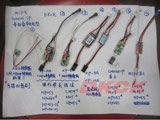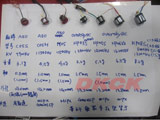

The stock Genius / Mini CP and Super CP comes with a brushed motor. This means it use DC current to run a brushed motor. The RX in the helicopter puts out DC current to run the motor. However, all brushless motor are 3 phase motors. This means there are 3 wires coming out of it, and they use AC current. To get from DC from the circuit board to AC for the motor, Walkera makes a ESC that reads the DC voltage coming out of the RX and put out 3 phase AC to run the motor. This is the easiest way to run brushless. For the more adventurous, there is a thing called BLHeli reprgrams certain off the shelf ESC so it can read in the DC voltage out of the RX board instead of a servo signal that it is designed to read in. The advantage of using an ESC other than Walkera one is that the aftermarket ESC is much lighter than the Walkera ESC.
Stock Genius: 41.7g AUW (All up Weight), Stock motor: 6.58g, C05 motor: 4.3g, Walkera ESC: 3.2g/2.5g with shrink wrap/without shrink wrap and connector. TGY DP 3A, and other simlar micro ESC: 1g
Power curves for stock and C05 motor. Will need to use mCPX V3 tail blade or the tail will loose authority to keep helicopter from spinning due to powerful motor.
First note: Pinion is .5 module for Genius / Mini CP / Super CP. Can get gears here.
Must see page on all the motor choice:
1. C05 with WK-WST-10A-LT Walkera brushless ESC. $15 - Most popular. Plug and play. Theoretical 0.9 gain with shrink wrap on ESC and 0.2 gain without. In practice: Gain 3-3.5 grams base on forum reports. Total weight = 44.6g AUW for Genius
2. C05 with "AeoRC Brushless Conversion + 5A" ESC. $22.95 - Good ESC - Plug and play. Gain 3.2 grams. Total weigth = 44.9g AUW for Genius.
3. C05 along with modified TGY DP 3A. - Best performance and lightest weight. Theoretical loose 1.3 grams. In actual with wires is about even.Total weigth = 41.9g AUW for Genius.
Note: C05 is the generic name for that size motor. They actually come in different kv and configuration. See the picture link above for more details. They weight from 3.1g to 4.5g. All C05 motors are larger diameter than stock, and canopy will require modification or some blocks to prevent rubbing since the outside of the motor turn with these out runner.
4. Use MCPx motor: Good power, but heavy. About 5.26g heavier at 11.74g. Total weight = 48.2g for Genius
5. Use HP03 motor. Not much smaller than C05, but lighter and less power. At 14000 kv, is very fast compared with 11500 kv for C05. Need to gear down. Probably a 7T. Stock is 9T. See posts. Dkfuji said kv is too high for stock gear. Motor will bog down. Need lower gear. Livonia bob said he did not find much increase in power (Probably too high gearing). The difference might be due to gearing. f.a.r.m.e.r. is using a hp03s with 7T. He said it flys pretty well with good power. Definitely, for a fast motor like the HP03S, low gearing is a must. Might even consider a 6T. In general, not too many good reviews on this one. Also interfere with canopy like the C05.
6. Official Walkera Genius CP double brushless conversion. 54g AUW with 350mAh battery. Rear use CB100 type rotor. Poor review on this one so far.
7. Walkera Mini CP motor: 9.4g, so is 2.8g heavier than stock Genius. Is heavy, but more powerful than the Genius. Initial comment is that it only flys for 3-4 minutes with the 240mah battery.
8. Neumotors Proton 12mm inrunner 14.74g available from 3200Kv to 11000Kv. In runner are more efficient than outrunner, but this one is heavy.
9. Turnigy 1015 inrunner 11500kv. 5.1g .51ohms. Right speed and right weight. The power on my sample was about the same as stock. 10mmx15mm (about same size as stock). Probably should gear down from the stock 9T to 7T for this small motor. For the XP-3A ESC with BLHeli, the settings should be Low for motor timing, Low for PWM Frequency and Demag Compensation = Off. Startup use Stepped method with .4 acceleration and 1.25 rpm. The advantage of this over stock would be brushless should be more durable than stock. Less weight between flight to cool down motor since it does not have brushes.
10. Turnigy 1220 inrunner 10300kv. 8.4g .342 ohms. Right speed, but slightly heavy. This may be the next best one after the 1015 Inrunner that was worse than stock motor.
11. Turnigy 1230 inrunner 4500 kv. 14.5g. .473 ohms. - Too slow and too heavy.
12. Cp-z-03 Motor. This IMHO is the best brushless for micro helicopters. Is smaller than the C05, but still plenty of power, and light.For tail motor, stock seems to work best and is light weight. With brushless, there is the issue of the motor stopping and difficulty starting. That leads to spinout.
Notes:
Best pinion to use for longest flight on C05 brushless is 7T.
Note: For the HobbyKing C05M motor, I believe it use standard M1.6X.35 screw for mounting. I had some M1.5X.4 on hand, and it seems to work fine. Since M1.5X.4 is a very rare size, most likely it use M1.6X.35, which is standard. Note the the frame is 1.5mm thick, so screws will need to be 3mm long minimum, but no more than about 5mm.
Regardless of what brushless motor you use, you will need to have an ESC to go along with it. The two recommended brushless ESC for micro helis is either the TGY DP-3A or XP-3A. They are very light. However, they will need the BLHeli reprogram to convert them to work with the Genius, Mini CP, Super CP or other Walkera or Blade mCPX micro heli. Which ever ESC you get, notice that the stock DP-3A and XP-3A use cheap FETs taht heats up and sucks up power. Be sure to furhter improve its performance by changing out the cheap FETs on the board.
You will need a USB programmer for the ESC to load the BLHeli mod onto the ESC.
3 pin femal micro connector to interface USB programmer. I used 120mm JST-SH1.0 Servo extension from HobbyKing
Brushless ESC of course.
Download either the BLHeliSuite or BLHeli-Setup. BLHeli-Setup is for ESC with SiLab processor. BLHeliSuite is for either AVG or SiLab processor. (I used the BLHeli-Setup. Guess the other can work too.)
Unzip the BLHeli-Setup.zip file
Connect the USB Toothstick connector to the proper location on the ESC. See here for connection points on the ESC to hook up to the programing stick so you can load BLHeli mod on the ESC. The BLHeli manual also has proper connection point. Best to connect a 3 pin female micro connector to the ESC to connect up with the USB Toothstick.
Solder the ESC as follows: Power input from ESC to the helicopter power. Connect ESC signal wire to either the negative motor terminal on helicopter or to the MOSFET gate. Motor positive terminal on the helicopter will be left open.
Run the BLHeliSetup.exe program without anything plugged in.
For the USB Toothstick programer, select: Interface->Silabs Toothstick Interface
Turn on transmitter and plug in helicopter. Wait for bind.
Plug ESC into USB Toothstick programer. Plug Toothstick USB into computer USB port.
Press connect in the BLHeliSetup program.
Press Flash BLHeli -> Select the ESC. Select the version of the software. ***For the Super CP, use a T.Hiro based program. See this page on the site.***
Do a Read Setup to verify that the ESC has flashed.
Keep all parameters stock except:
Low voltage limiter=Off (There is already telemetry alarm for voltage if you flashed the Super CP with updated firmware); Governor=off; ReArming every Start=unchecked (Don't frustrate yourself. These small helis are not that dangerous IMHO.); Programming by Tx=unchecked (ESC will detect the pulse duty cycle anyway. 0% duty cycle =0 throttle, and 100% duty cycle =100% throttle. No need to program the ESC for throttle range.); Input Polarity= Positive (for signal connected to FET) =Negative for (signal connected to motor neg); Beep Strength = Less than 50. If beep strength is too high DP-3A does not seem to work; Throttle Change Rate = 255.
Press Write Setup.
After writing setup, don't just disconnect the ESC, press Disconnect before disconnecting, or the program will crash. Leave the Toothstick programmer in the computer, just disconnect the ESC.
To arm the ESC, turn on transmitter then helicopter. When helicopter has initialized, give the throttle a 20% blip and back to 0%. ESC should give a beep when throttle is at 20%, then another beep when throttle is back at 0%. ESC is then armed and ready to go. The DP-3A sometimes has trouble arming. Have to give it part throttle, wait for the beep. Down to 0 throttle. Another part throttle, wait for the beep and down to zero before I get the beep at 0 throttle to indicate the ESC is armed.
If you need to change any settings, plug ESC to Toothstick programmer (that should already be in the computer) and press connect, then change setting. Afterward, press Disconnect, and unplug ESC.
SimokK Firmware for ESC using Atmega processor. The DP and XP 3A ESC do not use Atmega, but SiLabs instead, so this is not relevant. Is here just for reference. Link
Database of many ESC with pictures and what processor they use. Link
Link to a BLHeli project where Songlim did a double brushless set-up on his Mini CP.
BLHeli Discussion on Helifreak.
Another thread on BLHeli for SiLabs chips.
-----------------------------------------------------------------------------------------------------------------------------------------------------------------------------------------------------